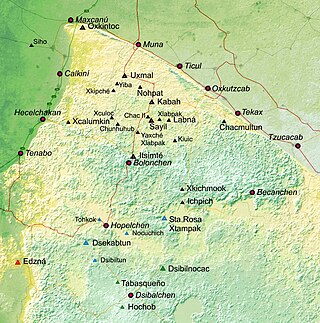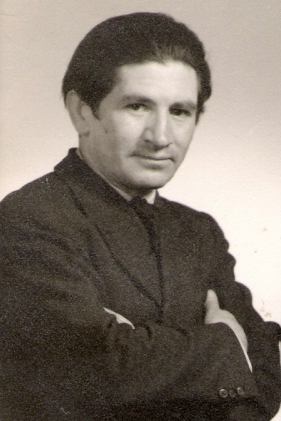
Puuc is the name of either a region in the Mexican state of Yucatán or a Maya architectural style prevalent in that region. The word puuc is derived from the Maya term for "hill". Since the Yucatán is relatively flat, this term was extended to encompass the large karstic range of hills in the southern portion of the state, hence, the terms Puuc region or Puuc hills. The Puuc hills extend into northern Campeche and western Quintana Roo.

The Ibero-American Exposition of 1929 was a world's fair held in Seville, Spain, from 9 May 1929 until 21 June 1930. Countries in attendance of the exposition included: Portugal, the United States, Brazil, Uruguay, Mexico, Peru, Argentina, Chile, Colombia, Cuba, Venezuela, the Dominican Republic, Bolivia, Panama, El Salvador, Costa Rica, and Ecuador. Each Spanish region and each of the provinces of Andalusia were also represented.

The Barcelona Pavilion, designed by Ludwig Mies van der Rohe and Lilly Reich, was the German Pavilion for the 1929 International Exposition in Barcelona, Spain. This building was used for the official opening of the German section of the exhibition. It is an important building in the history of modern architecture, known for its simple form and its spectacular use of extravagant materials, such as marble, red onyx and travertine. Furnishings specifically designed for the building, including the Barcelona chair, are still in production. It has inspired many important modernist buildings. The original structure was demolished in 1930, and the existing reconstruction was completed in 1986.

El Castillo, also known as the Temple of Kukulcan is a Mesoamerican step-pyramid that dominates the center of the Chichen Itza archaeological site in the Mexican state of Yucatán. The temple building is more formally designated by archaeologists as Chichen Itza Structure 5B18.

The Plaza de España is a plaza in the Parque de María Luisa, in Seville, Spain. It was built in 1928 for the Ibero-American Exposition of 1929. It is a landmark example of Regionalism Architecture, mixing elements of the Baroque Revival, Renaissance Revival and Moorish Revival (Neo-Mudéjar) styles of Spanish architecture.
The Mayan architecture of the Maya civilization spans across several thousands of years, several eras of political change, and architectural innovation before the Spanish colonization of the Americas. Often, the buildings most dramatic and easily recognizable as creations of the Maya peoples are the step pyramids of the Terminal Preclassic Maya period and beyond. Based in general Mesoamerican architectural traditions, the Maya utilized geometric proportions and intricate carving to build everything from simple houses to ornate temples. This article focuses on the more well-known pre-classic and classic examples of Maya architecture. The temples like the ones at Palenque, Tikal, and Uxmal represent a zenith of Maya art and architecture. Through the observation of numerous elements and stylistic distinctions, remnants of Maya architecture have become an important key to understanding their religious beliefs and culture as a whole.
Ancient Maya art comprises the visual arts of the Maya civilization, an eastern and south-eastern Mesoamerican culture made up of a great number of small kingdoms in present-day Mexico, Guatemala, Belize and Honduras. Many regional artistic traditions existed side by side, usually coinciding with the changing boundaries of Maya polities. This civilization took shape in the course of the later Preclassic Period, when the first cities and monumental architecture started to develop and the hieroglyphic script came into being. Its greatest artistic flowering occurred during the seven centuries of the Classic Period.

Maya Revival is a modern architectural style popular in the Americas during the 1920s and 1930s that drew inspiration from the architecture and iconography of pre-Columbian Mesoamerican cultures.

Chichén Itzá was a large pre-Columbian city built by the Maya people of the Terminal Classic period. The archeological site is located in Tinúm Municipality, Yucatán State, Mexico.

The 1929 Barcelona International Exposition (also 1929 Barcelona Universal Exposition, or Expo 1929, officially in Spanish: Exposición Internacional de Barcelona 1929 was the second World Fair to be held in Barcelona, the first one being in 1888. It took place from 20 May 1929 to 15 January 1930 in Barcelona, Spain. It was held on Montjuïc, the hill overlooking the harbor, southwest of the city center, and covered an area of 118 hectares at an estimated cost of 130 million pesetas. Twenty European nations participated in the fair, including Germany, Britain, Belgium, Denmark, France, Hungary, Italy, Norway, Romania and Switzerland. In addition, private organizations from the United States and Japan participated. Hispanic American countries as well as Brazil, Portugal and the United States were represented in the Ibero-American section in Sevilla.
Chichen Itza and Tula have numerous architectural similarities in a number of their constructions. This Toltec-Maya connection is widely considered powerful, unprecedented, and unique in Mesoamerica. Unlike most Maya sites, some of Chichen Itza's buildings have the traits of the Toltecs, a historically powerful indigenous group from modern-day Mexico. The explanation of these similarities is a point of controversy among the scholars of the Toltec and Maya fields. Certain historical records caused many early scholars of the region to assume that a Toltec invasion from Tula, Hidalgo, usually placed in the ninth or tenth centuries, was responsible for a new wave of Mexican-style Maya buildings after the rest of the buildings in Chichen Itza were built. Other historical accounts imply a migration from Tula to Chichen Itza. An account of the Tula records a ruler of the Toltecs travelling east, which, paired with another account of Chichen that records a ruler from the west coming and teaching the Maya of that city many things, supported a direct influence of the Toltecs on the Maya around 900–1000 A.D. However, recent radiocarbon dating suggests that Chichen Itza's ‘mexicanized’ and pure Maya constructions were built at the same time, and that both were built prior to any recorded Toltec invasion, and prior to the banishing of the semi-historical ruler. The precise connection between these two nations is unknown, and fiercely contested among scholars of Toltecs and Maya, but it is not disputed that no other counterparts to these two cities are found in the 800 mile distance between them. Established contradicting theories and a lack of information cause the precise relationship between Chichen Itza and Tula, Hidalgo to be fervently contested.

The Archeological Museum of Seville is a museum in Seville, southern Spain, housed in the Pabellón del Renacimiento, one of the pavilions designed by the architect Aníbal González. These pavilions at the Plaza de España were created for the Ibero-American Exposition of 1929.

The Atlantean figures are four anthropomorphic statues belonging to the Toltec culture in pre-Columbian Mesoamerica. These figures are "massive statues of Toltec warriors". They take their post-Columbian name from the European tradition of similar Atlas or Atalante figures in classical architecture.

The Parque de María Luisa is a public park that stretches along the Guadalquivir River in Seville, Spain. It is Seville's principal green area.

La Casa de la Ciencia in the city of Seville, Spain is a centre for popularizing science.

The Lope de Vega Theatre is a small Baroque Revival theatre that was built for the Ibero-American Exposition of 1929 in Seville, Spain, in the same building as the Exhibition Casino. It stands on the Avenida Maria Luisa street near the Maria Luisa Park just north of the Pavilion of Peru. The theater is named after the famous 16th-century Spanish playwright Lope de Vega. After the exposition the theatre had a mixed history. It suffered damage from fire and flood. At times it was closed and at times was partially restored and reopened. The building has been used as a hospital and as a trade show venue. Following its most recent renovation the theatre has become one of Seville's most important centres for cultural events.
The Toltec Empire, Toltec Kingdom or Altepetl Tollan was a political entity in pre-Hispanic Mexico. It existed through the classic and post-classic periods of Mesoamerican chronology, but gained most of its power in the post-classic. During this time its sphere of influence reached as far away as the Yucatan Peninsula.

Rómulo Rozo Peña was a sculptor. Some authors confirm that he was born in Chiquinquirá, Boyacá. He lived a major part of his life in Mexico. He married Ana Krauss in Czechoslovakia and had three children: Rómulo, Gloria and Leticia. His second wife was Manuela Vera, yucateca, with whom he had two children: Marco Antonio and Gloria Antonia. Rozo is best known for his internationally recognized sculpture, Bachué, which influenced a generation of Colombian artists.

Aníbal González Álvarez-Ossorio was a Spanish architect who made important buildings in Seville and Madrid. At the beginning of his career his style was Art Deco, but later evolved towards regionalism. He designed the Plaza de España and he was the chief architect of the Ibero-American Exposition of 1929 in Seville.

The Peruvian pavilion is a multi-purpose building in Seville, Spain. Built to house the Peruvian exhibition of the 1929 Ibero-American Exposition, it currently functions as the Consulate-General of Peru in the city and also houses a science museum, La Casa de la Ciencia.


















